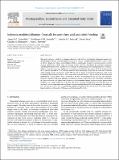Files in this item
Ischemia-modified albumin : crosstalk between fatty acid and cobalt binding
Item metadata
| dc.contributor.author | Coverdale, James P. C. | |
| dc.contributor.author | Katundu, Kondwani G. H. | |
| dc.contributor.author | Sobczak, Amélie Isabelle Sylvie | |
| dc.contributor.author | Arya, Swati | |
| dc.contributor.author | Blindauer, Claudia A. | |
| dc.contributor.author | Stewart, Alan J. | |
| dc.date.accessioned | 2018-08-22T11:30:06Z | |
| dc.date.available | 2018-08-22T11:30:06Z | |
| dc.date.issued | 2018-08 | |
| dc.identifier | 254989571 | |
| dc.identifier | d840a029-870f-4a12-8591-31bbcb78b993 | |
| dc.identifier | 85051104665 | |
| dc.identifier | 000443663700020 | |
| dc.identifier.citation | Coverdale , J P C , Katundu , K G H , Sobczak , A I S , Arya , S , Blindauer , C A & Stewart , A J 2018 , ' Ischemia-modified albumin : crosstalk between fatty acid and cobalt binding ' , Prostaglandins, Leukotrienes and Essential Fatty Acids , vol. 135 , pp. 147-157 . https://doi.org/10.1016/j.plefa.2018.07.014 | en |
| dc.identifier.issn | 0952-3278 | |
| dc.identifier.uri | https://hdl.handle.net/10023/15855 | |
| dc.description | This work was supported by the Leverhulme Trust (grant ref. RPG-2017-214), BBSRC (grant ref. BB/J006467/1) and the British Heart Foundation (grant refs. PG/15/9/31270 and FS/15/42/31556). | en |
| dc.description.abstract | Myocardial ischemia is difficult to diagnose effectively with still few well-defined biochemical markers for identification in advance, or in the absence of myocardial necrosis. “Ischemia-modified albumin” (IMA), a form of albumin displaying reduced cobalt-binding affinity, is significantly elevated in ischemic patients, and the albumin cobalt-binding (ACB) assay can measure its level indirectly. Elucidating the molecular mechanism underlying the identity of IMA and the ACB assay hinges on understanding metal-binding properties of albumin. Albumin binds most metal ions and harbours four primary metal binding sites: site A, site B, the N-terminal site (NTS), and the free thiol at Cys34. Previous efforts to clarify the identity of IMA and the causes for its reduced cobalt-binding capacity were focused on the NTS site, but the degree of N-terminal modification could not be correlated to the presence of ischemia. More recent work suggested that Co2+ ions as used in the ACB assay bind preferentially to site B, then to site A, and finally to the NTS. This insight paved the way for a new consistent molecular basis of the ACB assay: albumin is also the main plasma carrier for free fatty acids (FFAs), and binding of a fatty acid to the high-affinity site FA2 results in conformational changes in albumin which prevent metal binding at site A and partially at site B. Thus, this review advances the hypothesis that high IMA levels in myocardial ischemia and many other conditions originate from high plasma FFA levels hampering the binding of Co2+ to sites A and/or B. This is supported by biophysical studies and the co-association of a range of pathological conditions with positive ACB assays and high plasma FFA levels. | |
| dc.format.extent | 11 | |
| dc.format.extent | 1176971 | |
| dc.language.iso | eng | |
| dc.relation.ispartof | Prostaglandins, Leukotrienes and Essential Fatty Acids | en |
| dc.subject | Albumin cobalt binding assay | en |
| dc.subject | Molecular diagnostics | en |
| dc.subject | Free fatty acids | en |
| dc.subject | Human serum albumin | en |
| dc.subject | Myocardial ischaemia | en |
| dc.subject | QD Chemistry | en |
| dc.subject | R Medicine | en |
| dc.subject | SDG 3 - Good Health and Well-being | en |
| dc.subject.lcc | QD | en |
| dc.subject.lcc | R | en |
| dc.title | Ischemia-modified albumin : crosstalk between fatty acid and cobalt binding | en |
| dc.type | Journal item | en |
| dc.contributor.sponsor | British Heart Foundation | en |
| dc.contributor.sponsor | British Heart Foundation | en |
| dc.contributor.sponsor | BBSRC | en |
| dc.contributor.sponsor | The Leverhulme Trust | en |
| dc.contributor.institution | University of St Andrews. School of Medicine | en |
| dc.contributor.institution | University of St Andrews. Cellular Medicine Division | en |
| dc.contributor.institution | University of St Andrews. Biomedical Sciences Research Complex | en |
| dc.contributor.institution | University of St Andrews. Institute of Behavioural and Neural Sciences | en |
| dc.identifier.doi | https://doi.org/10.1016/j.plefa.2018.07.014 | |
| dc.description.status | Peer reviewed | en |
| dc.identifier.grantnumber | FS/15/42/31556 | en |
| dc.identifier.grantnumber | PG/15/9/31270 | en |
| dc.identifier.grantnumber | BB/J006467/1 | en |
| dc.identifier.grantnumber | RPG-2017-214 | en |
This item appears in the following Collection(s)
Items in the St Andrews Research Repository are protected by copyright, with all rights reserved, unless otherwise indicated.

